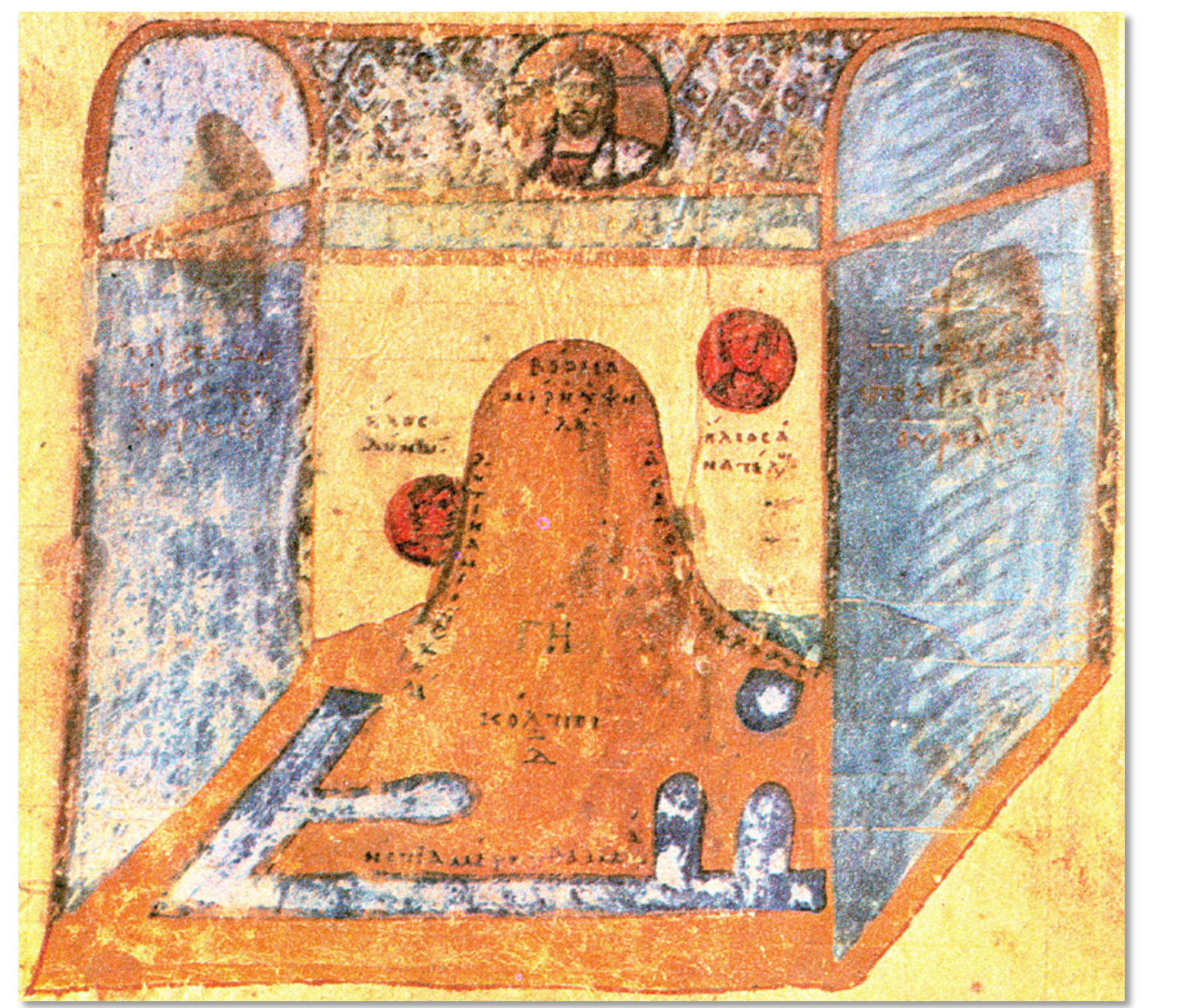Image: Christian Topography of Cosmas Indicopleustes. Codex Sinaiticus graecus 1186 fol. 66v: Map of the earth, 67r: οἰκουμένη - the habitable earth. Sinai (?), early 11th century. Brown, white, and red ink and gold on parchment.
The richest in illustrations of three illuminated manuscripts of the book, on display at the Metropolitan Museum, New York in the exhibition Africa and Byzantium
The text from exhibit’s label in the Metropolitan Museum:
“Originally written in Greek by Alexandrian merchant Cosmas Indicopleustes (“Cosmas who sailed to India”) in the sixth century, this copy of the book is a travelogue of sorts. Among the many maps Cosmas provided are those of trade routes along the coast of Africa, especially Aksum. For more than a thousand years, this book has been cared for by the monastic fathers of the Holy Monastery of Saint Catherine, Sinai. This text represents how significant documents originating from northern Africa circulated throughout the world.”
Vom Berge des Nordens
Eutokios sagte: »Noch einmal siegen die ewig Unheilbaren. Die nicht begreifen können, daß die 100000 Jahre der Metaphysik vorbei sind, und die der Physik angefangen haben: Wir, Lykophron, wissen, wohin wir gehören!« – Er schwenkte die Knochenhand hoch, würdevoll, eine strenge Raumkurve – und ich riß den Kopf: da standen wir: Menhirs in christlicher Nacht! – (Wind schob sich gleich dazwischen; unsere Boote jankten; Blödheit der Geräusche; ein Fluch schlitzte mir den Mund: erzeugt Paradiese: aber ohne Mich!! (Möchten die Christenpriester einst Gleiches erfahren! Unsere Rächer trinken zukunftssicher ihren Kumys im Imaus!). – – – (Arno Schmidt, Kosmas oder vom Berge des Nordens)
As Arno Schmidt notices, the most remarkable thing in the Christian Topography is the very original cosmology which Cosmas Indicopleustes outlines.
In Ptolemy’s model of the solar system all celestial bodies including the earth in the centre are spheres. For centuries before and after Cosmas, this had been the widely accepted foundation of astronomy.

In great detail, Cosmas, however, dismisses Ptolemy’s spheres, using fanciful mathematics and geometry and creatively ignoring many astronomical facts like e.g, the approximate distance from earth to sun, or the circumference of the earth, facts that were known and generally accepted at his time. Instead, Cosmas shapes his world like the tabernacle, a rectangular box with a vaulted ceilling, the celestial bodies being circled by angels at ⅔ of the hight around a giantic cone shaped mountain. The shadow which this mountain of the north casts, makes the night dark. Above image is from the same Sinai manuscript.
Ἡ γῆ μὲν πᾶσα τετράγωνός ἐστι, καθὰ προεγράφη. Τὸ ἀνάστημα δὲ αὐτῆς τῆς μεσοτάτης καὶ τὰ ὕψη τὰ κατὰ βόρεια καὶ δυτικὰ μέρη ἐσημάναμεν ἐνταῦθα διαγράψαντες ὅπως, μέση τυγχάνουσα καὶ πέριξ ἔχουσα τὸν Ὠκεανὸν καὶ πάλιν πέριξ τὴν ἄντικρυς γῆν, τῶν ἄστρων κυκλευόντων αὐτήν, δύναται καὶ κῶνον ἀποτελεῖν τὴν σκιὰν κατὰ τοὺς ἔξω, καὶ ὅτι καὶ κατὰ τὸ σχῆμα τοῦτο δύνανται καὶ αἱ ἐκλείψεις τῆς σελήνης ἀποτελεῖσθαι καὶ νύκτες καὶ ἡμέραι, καὶ ἡ θεία Γραφὴ μᾶλλον ἀληθεύει λέγουσα· «Ἀνατέλλει ὁ ἥλιος καὶ δύνει ὁ ἥλιος καὶ εἰς τὸν τόπον αὐτοῦ ἕλκει· ἀνατέλλων αὐτὸς ἐκεῖ πορεύεται πρὸς νότον καὶ κυκλοῖ πρὸς βορρᾶν· κυκλοῖ κυκλῶν, καὶ ἐπὶ κύκλους αὐτοῦ ἐπιστρέφει τὸ πνεῦμα», ὡσανεὶ τὸν ἀέρα κυκλεύων πάλιν εἰς τὸν τόπον αὐτοῦ ἐπανήκει.
The earth taken as a whole is quadrangular according to the delineation already given. We have also indicated the altitude of its most central part and the heights in its northern and western parts. Hence we have delineated it as placed in the centre surrounded by the ocean and also by the earth on the opposite side of the ocean, with the heavenly bodies circling round it, so that the conical mountain16 can project a shadow according even to the pagans, while in accordance with this figure eclipses can occur, as well as the vicissitudes of night and day. Divine scripture confirms the truth of this, saying: The sun riseth and the sun goeth down, and draweth to his own place. On his rising he goeth then to the south and wheeleth his circles, and turneth round the air upon his circles;17 meaning that in circling through the air he comes back again to his own place. (Chapter 4, paragraph 11; Translation by Crindle 1897)
